Reasons to Buy Nikon AF Micro-Nikkor 60mm f2.8D Lens
Here we’ve included a summary of the advantages and disadvantages of the Nikon AF Micro-Nikkor 60mm f2.8D lens in a list form to help you determine whether it offers the features you need.
PROs
| Autofocus |
| Aperture Ring |
| Distance Scale |
| DoF(Depth of Field) Scale |
| Covers Full-Frame Sensor |
| High Max Magnification ratio of 1x |
| Minimum focus distance of 0.22m / 8.7 inch |
Report a correction
Buy Nikon Micro-60mm f2.8D from or B&H PHOTO
CONs
| Hood is not supplied |
Lens Mount
Nikon Micro-60mm f2.8D is compatible with cameras that have a Nikon F (FX) lens mount. Some of the latest released cameras that are compatible with the Nikon F (FX) lenses are Nikon D6, Nikon D780 and Nikon D3500.
Size, Weight and Filter Thread
Size and weight is a very important decision factor when searching for your next lens. Nikon Micro-60mm f2.8D has a maximum diameter of 70mm and total length of 75mm. It weighs 440g / 15.5 oz.
Nikon Micro-60mm f2.8D has a filter thread of 62mm. Below are links to the filters that we recommend you to consider for your Nikon Micro-60mm f2.8D:
Optical Image Stabilization
Nikon Micro-60mm f2.8D doesn’t have an optical image stabilization system so the only option to stabilize the image taken with this lens is to mount on a camera body with IBIS (sensor based In-body image stabilization).
Maximum Magnification Ratio
Nikon Micro-60mm f2.8D has a Max Magnification Ratio of 1x and has a minimum focusing distance of 0.22m.
Below are the 3 Macro Prime type Nikon F mount lens alternatives with highest max magnification ratios:
- Venus 25mm F2.8 2.5-5X Ultra Macro: 5x — (Compare)
- Venus 24mm F14 2x Macro Probe: 2x — (Compare)
- Venus 100mm F2.8 2X Ultra Macro : 2x — (Compare)
Lens Hood
Nikon Micro-60mm f2.8D doesn’t come with a lens hood. You have to order the hood separately and the model number of the hood is HB-22.
Popular Comparisons of Nikon Micro-60mm f2.8D
Top Alternatives of Nikon Micro-60mm f2.8D Lens
| Model | Coverage | Weight | Focusing | Street Price | |
|---|---|---|---|---|---|
|
Nikon AF-S Micro-Nikkor 60mm f2.8G ED Compare |
35mm FF | 425 g / 0.94 lb | AF | ||
|
Tamron SP AF 60mm F2 Di II LD IF Macro Compare |
APS-C / DX | 400 g / 0.88 lb | AF | ||
|
Nikon AF-S Nikkor 50mm f1.8G Compare |
35mm FF | 185 g / 0.41 lb | AF | ||
|
Tamron SP AF 90mm F2.8 Di Macro Compare |
35mm FF | 405 g / 0.89 lb | AF | ||
|
Sigma 70mm F2.8 DG Macro Art Compare |
35mm FF | 515 g / 1.13 lb | AF | ||
|
Voigtlander 58mm F1.4 Nokton SL II Compare |
35mm FF | 320 g / 0.70 lb | MF | ||
|
Sigma 50mm F2.8 EX DG Macro Compare |
35mm FF | 320 g / 0.70 lb | AF | ||
|
Carl Zeiss Makro-Planar T 250 Compare |
35mm FF | 530 g / 1.17 lb | MF |
Тема: NIKON D80 + NIKKOR 60/2.8, 105/2.8 VR Macro = несовместимость циферок и понимания!
Ресурс: Клуб Foto.ru
Форум: Обсуждение фототехники
Автор реплики: JEWELLER
А что ВЫ скажите по поводу это стекла SIGMA AF 150 mm f/2.8 EX DG APO MACRO HSM? Это НАСТОЯЩЕЕ макро? Так вот, с этим объективом проблем нет! Выставил 2.8, так оно и стоит 2,8!!! Причем на самой минимальной дистанции фокусировки! И где Вы начитались такого, что объектив всем должен заправлять?
Автор реплики: Mik_S
Если вы снимали на минимальной дистанции фокусировки, то «стоит» оно не F/2.8, а существенно меньше. а что пишет при этом Сигма по прежнему 2.8 — так это как раз ее проблемы. И если пользоваться автоматикой замера, то приводит к недоствету. В отличие от Никоновских объективов, которые честно сообщают реальную светосилу. Меняющуюся, как ей положено, при отодвигании фокальной плоскости линзы от кадра.
При увеличении масштаба изображения у объектива падает светосила. Это — оптика и никуда от этого не денешься. С любой камерой и с любым объективом будет так.
Никоновские макро-объективы, снабженные процессором, честно отражают сей факт (а также тамроновские, возможно и еще какие-то). Какие-то (в том числе «ручные») не отражают («ручным» это отражать просто нечем). Что, кстати, при использовании внутрикамерного TTL-замера мало на что не влияет, потому что замер меряет реальное кол-во света прошедшее через объектив и на основании этого «принимает решение» — на сколько надо закрыть диафрагму. Не до какого численного значения, а именно «на сколько ступеней по сравнению с намерянным».
iTTL оперирует реальным значением светопропускания бъектива (выраженным через диафрагменное число) с тем, чтобы «предсказать» — сколько света понадобится для пыхания на дистанцию фокусировки (естественно, если объектив D) при данной диафрагме и данной чувствительности. А его обманывают — говоря, что светосила объектива выше, чем на самом деле (в макрозоне у Сигмы). Вот у iTTL крышу малость и сносит. Собственно, именно для этого — чтобе обеспечить корректную работу iTTL — никоновские объективы и передают в камеру «эффективное» значение светосилы. То есть, приведенное к тому, сколько света на самом деле попадает в кадр при данном «геометрическом» значении светосилы.
Если бы зависимость светосилы (про нее речь все-таки, наверное) от фокусного для всех зумов (про них речь все-таки, наверное) была одинаковой и предсказуемой — то запросто не писали бы… Но она разная, зависящая от конструкции объектива, и потому пишут.
А зависимость светосилы от дистанции фокусировки — вещь с одной стороны линейная и предсказуемая, с другой — на «обычный внутрикамерный замер» никак не влияющая… И проявляющая себя только при «внешнем» замере экпозиции и при работе с хитрыми системами управления вспышкой…
Test Shot Sharpness Comparison
- f/2.8 — Chromatic aberration in the corners which looks out of focus. Shockingly bad performance. I retested the lens on both the D750 and A7 because of how bad the image quality was.
- f/4 — Corners are still soft with very noticeable chromatic aberration.
- f/5.6 — The center is sharp, but the corners are still soft.
- f/8 — Outer edges of the corners are soft. Chromatic aberration is no longer visible.
- f/11 — Improvement in the corners. A slight loss in fine detail as diffraction is beginning to set in.
- f/16, f/22, f/32 — Diffraction progresses and sharpness gets worse.
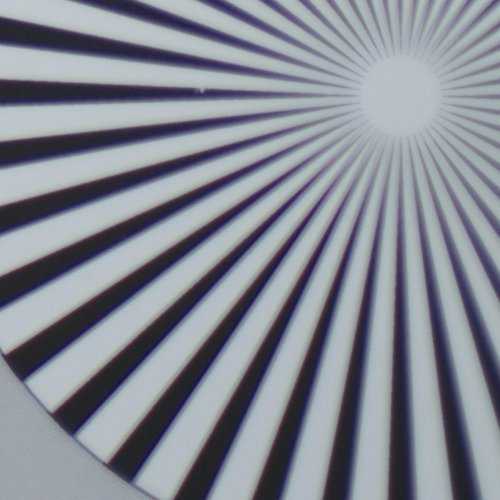 100% Corner Crop at f/4
100% Corner Crop at f/4
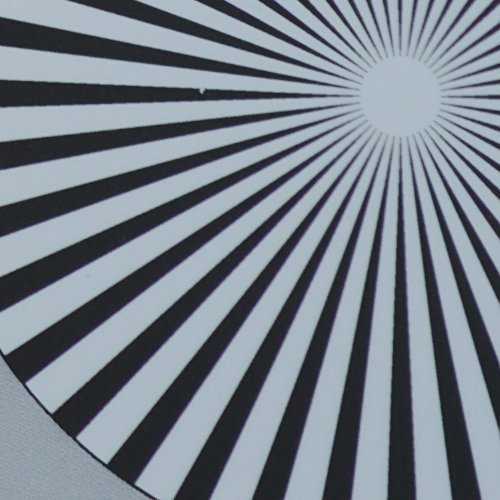 100% Corner Crop at f/11
100% Corner Crop at f/11
Autofocus
The autofocus is slow and inaccurate. Manual focusing is faster for closeup and macro magnification.
On my D750 the lens hunts around and I’m not surprised when the lens misses focus. Also, the auto focus is never going to work with an adapter.
This is an early AF design by Nikon that is driven by the camera body via a screw drive. Nikon is never going to produce an adapter capable of powering the auto focus in this lens.
Macro Magnification
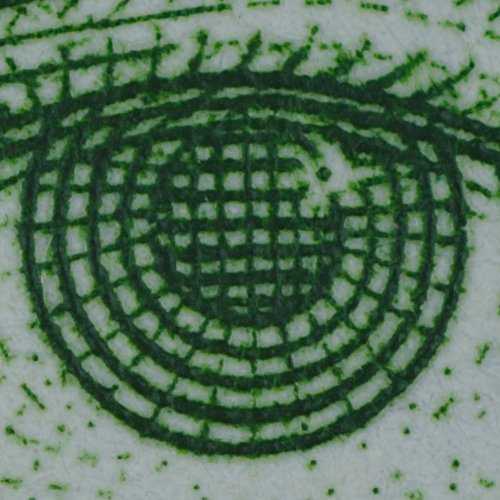 100% Crop, 1:1 Magnification at f/11
100% Crop, 1:1 Magnification at f/11
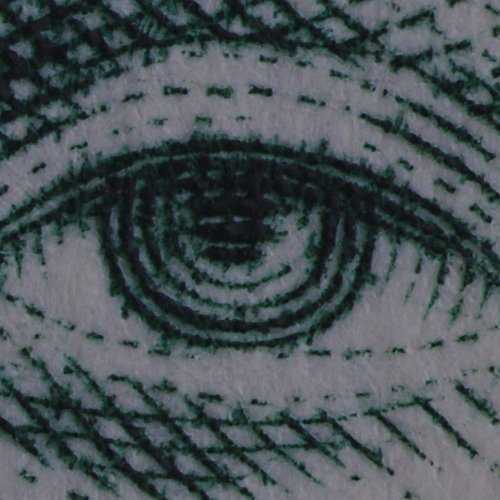 100% Crop, 1:1 Magnification, Taken with a Sony A7
100% Crop, 1:1 Magnification, Taken with a Sony A7
The lens is on the heavy side, the aperture is not easy to manually operate, and the image quality is lacking. I didn’t stick the lens on my bellows because I thought that it would be an annoying experience.
Underwhelming results don’t get better by extension or reversing a lens. There are better choices, like the Vivitar 55mm f/2.8.
Comparable Lenses
- Vivitar 55mm f/2.8 Macro — Available in several lens mounts.
- Micro Nikkor 55mm f/3.5 PC
- /(olympus-om-50mm-f-3-5-zuiko-auto-macro-lens-review/)
- Canon FD Macro 50mm f/3.5
Тема: Макрообъектив или удлинительные кольца на полтинник???
Ресурс: MacroClub.Ru — Клуб любителей макросъемки
Форум: Зеркальная техника для Макро
Автор реплики: Дмитрий Шакин
Использовал 7 лет Никкор 60/2,8 Микро — считаю его лучшим объективом среди существующих на сегодняшний день.
В силу обстоятельств перешел на Canon и соответственно взял макрообъектив Canon 50/2,8 (1:2). Ощущение китайской пластмассы не проходит до сих пор…
И никакие кольца мне сейчас не заменят масштаб 1:1! Кстати кольца нужны и к этому объективу (Никкор 60/2,, если Вы серьезно хотите снимать макро.
Только МикроНиккор 60/2,8 и кольца, например Кенко, с поддержкой никому не нужному в данном случае АФ (зато полная связь объектива с камерой).
Все остальное -хуже, поверьте. Сам прошел через эти муки выбора.
Build Quality, Design, and Sample Variation
The first thing that comes to my mind when handling the lens is the cheap plastic feeling. This is because the outer barrel of the lens is plastic, while the internals are made out of metal.
Instead of engraving, all of the text on the lens has been screen printed. Some of the text on my copy of the lens has begun to wear away. Personally, I prefer the build of earlier manual focus 55mm Micro Nikkors.
The lens has a manual/autofocus ring. This ring provides a way to change focus mode on the lens, rather than the camera.
There is a pin lock that keeps the ring in place. I do not find the pin comfortable to press, easy to locate, or enjoyable to use.
Another lens feature is the inclusion of a limit switch. When set to limit, the lens will not focus in the macro range. This will prevent focus hunting and speed up autofocus when close-focus is not needed.
I have no complaints about the location or the haptic feedback from toggling the switch.
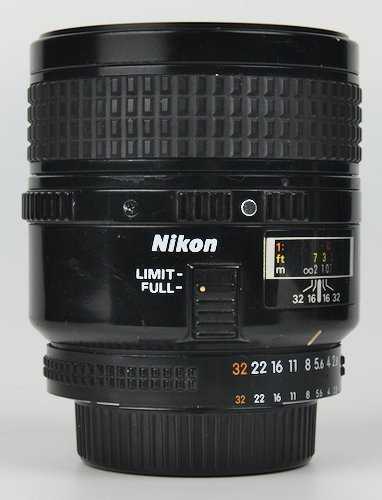 Focus Limit Switch and Focus Ring
Focus Limit Switch and Focus Ring
There is a window covering the distance scale. That is a nice feature to prevent water, dust, and debris from getting into the lens. It is a design feature that is shared among early AF and D-series lenses.
The autofocus in the lens is driven by the camera via a motor drive. It is also fairly heavy, which results in an awful manual focusing experience.
The focus ring is heavy, feels imprecise, and gives mechanical feedback when rotated. There are 360 degrees of travel between infinity and 1:1.
With the limit-switch engaged there is less than 90 degrees of travel. I do not like manually focusing with this lens.
Electronically controlling the aperture works great. There is a lock on the lens that will prevent the aperture from being changed once set to electronic control.
The aperture ring has a smaller diameter than the rest of the lens, which makes it hard to reach. A larger amount of force than expected is needed to manually change the aperture on the lens.
Manually changing the aperture was more difficult than it should be. I would often overshoot the aperture I wanted because it felt like it was stuck in place until it began to move.
This is not a problem with my copy of the lens, as the Nikon AF Micro Nikkor 105mm f/2.8 I have has the same problem. I quickly got annoyed with the aperture and focus ring with the lens adapted to a Sony A7.
My copy of the lens is in good condition. I don’t see any internal dust. There are no signs of problems with the grease.
Some of the printing on the barrel of the lens is worn. My only issue is that the manual/auto selector is a bit stiff and hard to switch. Overall, I am happy with how the lens has held up.
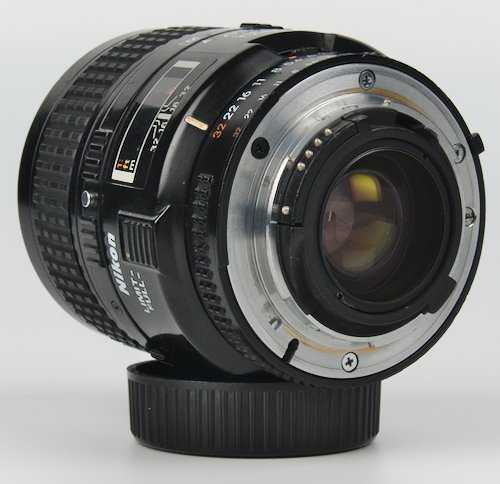 Nikon F-Mount Showing CPU Contacts
Nikon F-Mount Showing CPU Contacts
Lens Specifications
| Manufacture | Nikon |
| Made in | Japan |
| Year Released | 1989 |
| Original Price | $277.95* |
| Elements Groups | 8 ele. 7 gr. |
| Focal Length | 60mm |
| Aperture | f/2.8-32 |
| # Aperture Blades | 7 |
| Aperture Control | Manual, Auto Diaphragm |
| Focus Type | Manual |
| Hard Infinity Stop | Yes |
| Magnification | 1:1 |
| Minimum Focus Distance | 21.9cm (8.6”) |
| Working Distance | 7.5cm (2-15/16″) |
| Filter Threads | 62mm |
| Weight | 16oz (460g) |
| Dimensions | ⌀70mm x 96mm (2.75″ x 3.75″) |
Note: Price is from a 1989 Competitive Camera Corp Catalogue.
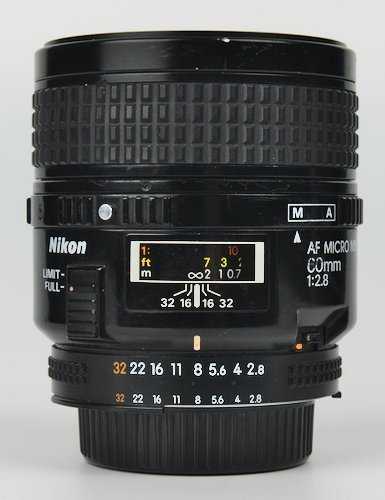 Lens Distance Window and Aperture Ring
Lens Distance Window and Aperture Ring
Accessories
The HN-22 lens hood is designated for this lens. Increasing the lens magnification brings the front element forward.
At 1:1 magnification the front element is only recessed into the lens by ~1/2″ (13mm). When focused at infinity the front element is recessed ~1.5″ (4cm).
A lens hood should not be necessary for most shooting. For situations that can be highly prone to lens flare, a lens hood would be good to have.
Conclusion
If the lens is cheap enough, or you already own a copy of the lens, it is fine. The performance at f/8 is in line with every other comparable macro lens I have tested.
The performance at wider apertures is poor in comparison with less expensive lenses. In fact, I prefer the earlier Micro Nikkor-PC 55mm f/3.5 to this lens. I expect both of the AF Micro Nikkor 60mm lenses to depreciate in the coming years as Nikon transitions from the F-mount to the mirrorless Z-mount.
Screw drive auto focus lenses are going to fall in value. Nikon did not release an adapter that is able to power the auto focus on the screw drive AF lenses with the release of the Z6 and Z7.
The manual focus experience is not as good as fully manual lenses or with lenses that have AF motors built-in. All of the screw drive lenses that do not offer exceptional performance are going to be dropping in value over the next decade. I expect both of the 60mm AF Micro Nikkor lenses to lose value in the coming years.
I would not recommend buying this lens. In fact, if you own a copy of this lens, I suggest selling it. There are other options that are better suited to be adapted to mirrorless cameras. On top of that, they also likely perform better. I would prefer to use any of the lenses listed below:


























